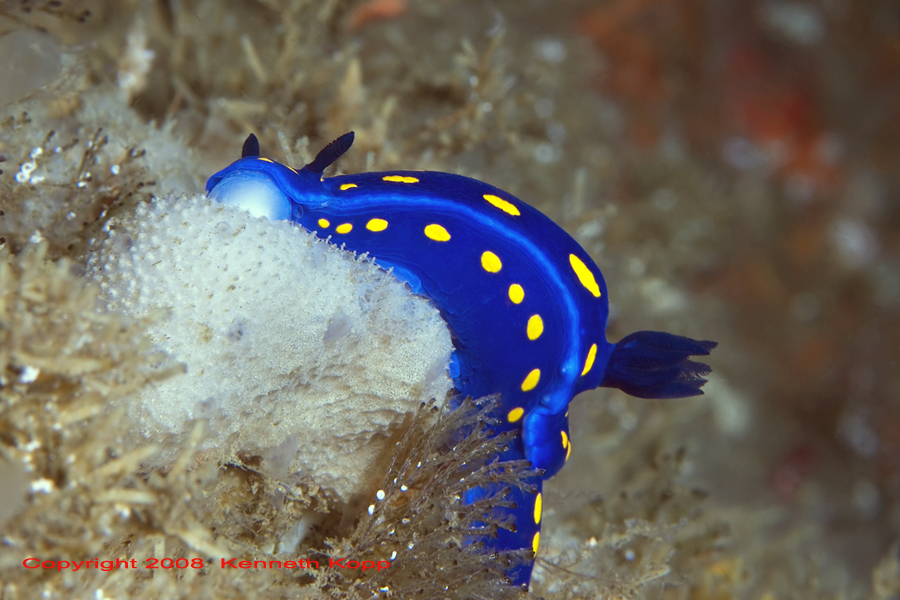 |
Hypselodoris californiensis
Catalina Island, California Photo courtesy of Kenneth Kopp
Hypselodoris californiensis , (Bergh, 1879)
Due to its rarity, every observation of this beautiful chromodorid stirs quite a ruckus. This is exactly what happened when Claudette and Ken came across this specimen. Ken sent me this “I was diving the Catalina dive park with professional Nudi spotter, Claudette Dorsey , when she looked over at me with eyes the size of saucers. She put up a hand, and counted 1, 2, 3 and then turned and pointed to yet another Hypselodoris californiensis. This is our 5th one in the Catalina dive park over the last 2+ years.”
This note was followed up with several questions. I am including the answers here.
What is the blue pouch on the head of the animal and do they have a radula? This is the extended buccal mass (mouth). All dorids feed by extending this mass out to make contact with their prey. All chromodorids are sponge feeders (page 87 in my Nudibranch Behavior book), and YES they do have a radula. The only dorids that don’t are the porostomes, Doriopsilla. They rasp away at the sponge with the radula tearing pieces off. (see photos pgs 72-78 in same book). It is like being licked by a cat. The radular teeth are on the tongue.
Ken also pointed out proof that the specimen was feeding on the sponge, note the exposed internal tissue of the sponge.
One last note of interest is we can see the acid glands at the edge of the mantle. These are the glands that secrete noxious chemicals when a wanton predator does not take heed of the bright “aposematic” warning coloration of this species.
Great photo Ken.
Gig Harbor, Washington
Jul., 2008
WEBMASTER'S NOTES
Boy, Ken's great image sure sets off the wonderlust in the ol' Webmaster! In fact, I
will be heading up to Catalina next week on a sea slug safari that I hope that includes Hypselodoris californiensis . Sure what like to get lucky and get HD video of this elusive branch!
I mean how can it hide with those flamboyant colors? For those of you that may be new to the site, Hypselodoris californiensis used to be common along the west coast of the United States.
Sometime in the late 80's or early 90's it started getting scarce based on the reduced number of sightings being reported. Now, the only area that it is being reported from with any degree of consistency is Avalon Harbor, Catalina Island.
I have only seen it once at Santa Barbara Island many years ago and being out of film, I have no personal pics of H. californiensi . Would love to hear about other recent sightings other than Avalon Harbor. Anyone
care to contribute????
San Diego, Calif
Jul., 2008
Kenneth Kopp

Diving since 1999. Currently doing about 250+ local dives a year. Favorite Nudibranch dives are Marine Land, Palos Verdes, CA and Anacapa Island, CA. We routinely see 12 - 14 species on a single dive at these sites. Got my first camera in 1974. Been shooting digital exclusively since 1998. Been shooting underwater about 4 years, and am currently shooting a Nikon D200 in the Light & Motion housing. Writer and Marketing executive by profession. When I'm dry, I'm usually fly fishing or pounding and shaking things as a working drummer & percussionist. Married, no kids. We have three house Rabbits. Yeah - its weird for me, too. See more of Ken's work at http://www.kennethkopp.com.
Send Ken email at kenneth@kennethkopp.com |
Taxonomic information courtesy of:

David W. Behrens
Author:
Pacific Coast Nudibranchs
Send Dave mail at dave@seachallengers.com
|
